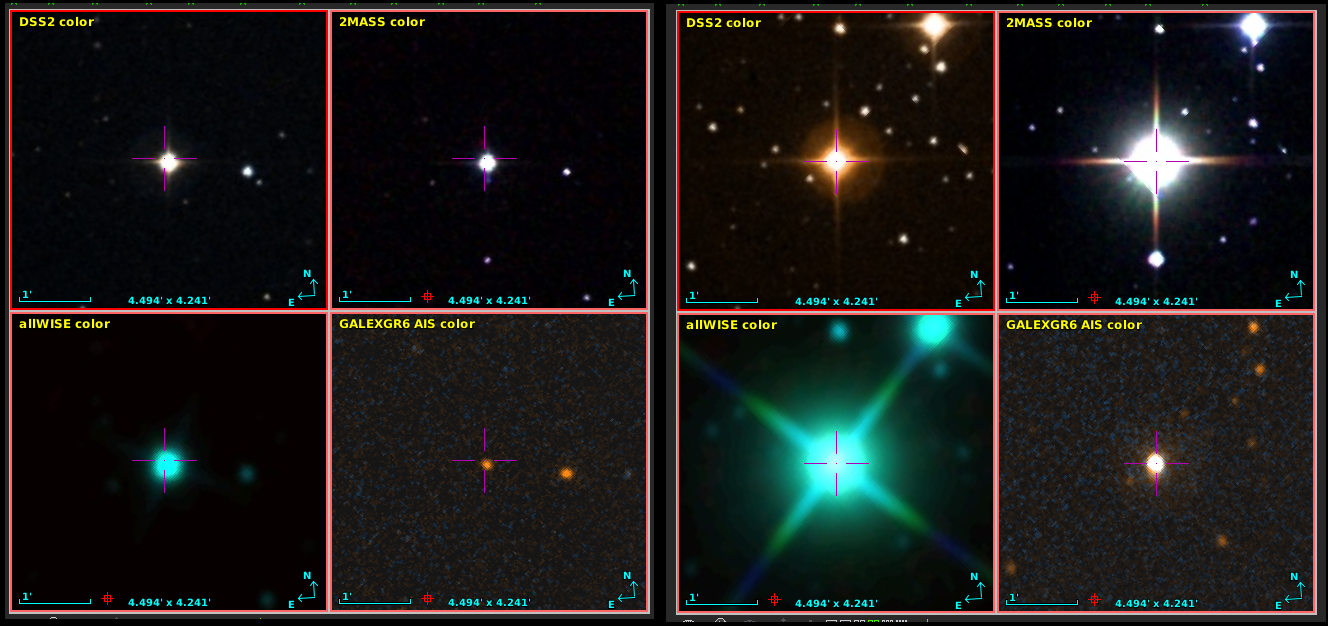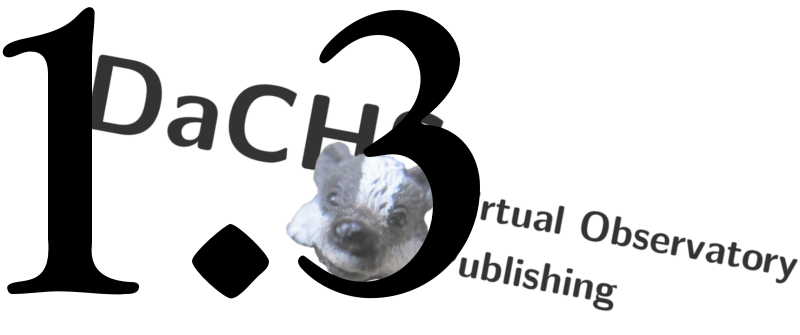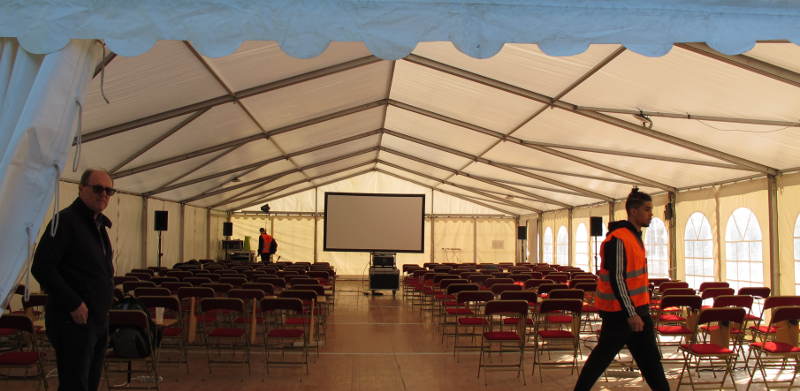2019-05-12
Markus Demleitner
About every six month, the people making the standards for the Virtual
Observatory meet to sort out the next things we need to tackle, to show
off what we've done, and to meet each other in person, which sometimes
is what it takes to take some excessive heat out of a debate or two.
We've talked about Interops before. And now it's time for
this (northern) spring's Interop, which is taking place in Paris
(Program).
This time I thought I'd see if there's any chance I can copy the pattern
I'm enjoying at Skyweek now and
then: A live blog, where I'll extend the post as I go. If that's a plan
that can fly remains to be seen, as I'll give seven talks until Friday,
and there's a plethora of side meetings and other things requiring my
attention.
Anyway, the first agenda item is a meeting of the TCG, the Technical
Coordination Group, which is made up
of the chairs and vice-chairs of the IVOA's working groups (I'm in there as the vice chair of the
semantics WG). We'll review how the standards under review progress,
sanction (or perhaps defer) errata, and generally look at issues of
general VO interest.
Update (2019-05-12, 10:50): Oh dang, my VOResource 1.1 Erratum 1
hasn't quite made it. You see, it's about authentication, i.e.,
restricting service access, which, in a federated, interoperating system
is trickier than you would think, and quite a few discussions on that
will happen during this Interop. So, the TCG has just decided to only
consider it passed if nothing happens this week that would kill it. To
give you an idea of other things we've talked about: Obscore 1.1
Erratum 1 and
SODA 1.0 Erratum 1 both try
to fix problems with UCD annoation (i.e., a rough idea what it is) not
directly related to the standards themselves but intended to help when
service results are consumed outside of the standard context, and
RegTAP 1.0 Erratum 1
fixes an example in the standard regulating registry discovery that
didn't properly take into account my old nemesis, case-insensitivity of
IVOA identifiers. So, yay!, at least one of my Errata made the TCG
review.
Update (2019-05-12, 12:15): Yay! After some years of back and forth,
the TCG has finally endorsed my Discovering Data Collections note. This is
another example of the class of text you don't really notice. It's
supposed to let you, for instance, type in a table name into TOPCAT and
then figure out at which TAP service to query it. You say: I can already
do that! I say: Yeah, but only because I'm running a non-standard
service, which I'd like to cease at some point.
Update (2019-05-12, 15:55): The TCG meeting slowly draws to an end.
This second half was, in particular, concerned with reports from Working
and Interest Groups; this is, essentially, an interactive version of the
roadmaps, where the various chairs say what they'd like to do in the six
month following an Interop. The one from after College Park (VO insiders
live by Interops, named by the towns they're in) you could read at 2018
B Roadmap in the IVOA Wiki – but
really, as of next Friday, you'd rather look at what's going be cooked
up here (which will be at 2019 A Roadmap).
Update (2019-05-12, 16:30) It's now Exec, i.e., the governing body
of the VO, consisting of the principal investigators (or, bosses), of
the national VO projects (I'm just sitting in for my boss, really). This
has, for instance, the final say on what gets to be a standard and what
doesn't. This is, of course, a bit more formal than
the hands-on debates going on in the TCG, so I get to look around a bit
in the meeting room. And what a meeting room they have here at Paris
observatory. Behind me there's a copy of Louis XIV's most famous
portrait
(and for a reason: Louis XIV had the main part of the building we're in
built), along the walls around me are the portraits of the former
directors of Paris observatory (among them names all mathematicians or
astronomers know: Laplace, Delaunay, Lalande, the Cassinis, and so on),
and above me, in the meeting room's dome, there's an allegoric image of
a Venus transit that I can't link here lest schools block this important
outreach site. What a pity we'll have to move into a tent when everyone
else comes in tomorrow...
Update (2019-05-13, 9:11) The logistics speech is being given by
Baptiste Cecconi, who's just given the carbon footprint of this meeting
– 155 tons of CO2 for travel alone, or 1.2 tons per person.
That, as he points out, is about what would be sustainable per year.
Well, they're trying to make amends as far as possible. We'll have
vegetarian-only food today (good for me), and locally grown food as far
as possible. Also, the conference freebie is a reusable cup so people
won't produce endless amounts of waste plastic cups. I have to say I'm
impressed.
Update (2019-05-13, 9:43): One important function of these meetings
is that when software authors and users sit together, it's much easier
to fix things. And, first success for me this time around: The LAMOST
services at the data center of the Czech academy of sciences do fast
positional searches now; you'll find them by looking for LAMOST in
TOPCAT's SSAP window, in
Aladin 10, in Splat, or really
whereever clients let you do discovery of spectral services in the VO.
Update (2019-05-13, 10:59): Next up: “Charge to the Working
Groups”. That's when the various working group chairs give lightning
talks on what's going to happen in their sessions and try to pull as
many people as they can. Meanwhile, in the coffee break, I've had the
next little success: With the people involved, we've worked out a good
way to fix a Registry problem briefly described by “two publishing
registries claim the same authority” (it's always nice to pretend I'm in
Star Trek) – indeed, we'll only need a single deletion at a single
point. Given the potential fallout of such a problem, that's very
satisfying.
Update (2019-05-13, 14:07): While the IG/WG chairs presented their
plans,
the Ghost of Le Verrier (or was it just the wind?) occasionally haunted
the tent, which gave off dreadful noises. And after the session, I
quickly ported the build infrastructure for the future EPN-TAP
specification (SVN for nerds;
previously in this blog for the rest of
you) to python 3. Le Verrier was quiet during that time, so I'm sure the
guy who led the way to the discovery of Uranus approved.
Update (2019-05-13, 14:29): Mark SubbaRao from Chicago's Adler
Planetarium is giving a plenary talk (in other places, this might be
called a ``keynote'') on Planetaria and the VO. And he makes the point that there's 150
million people visiting a plenetarium each year, which, he claims, is a
kind of outreach opportunity that no other science has. I'd not bet on
that last statement given all the natural history museums, exploratoria,
maker faires and the like, but still: That the existence of planetaria
says something about the relationship of the public with astronomy is an
insight I just had.
Update (2019-05-13, 15:07): So, you think you just sit back and
enjoy a colourful talk, and then suddenly there's work in there.
Specifially, there's a standard called AVM designed to annotate
astronomical images to show them in the right place on a planetarium
dome (ok, FITS WCS can do that as well) and furnish it with other
metadata useful in outreach and education. As Registry and Semantics
enthusiast, I immediately clicked on the AVM link at the
foot of http://www.data2dome.org and was
greeted by something pretty close to a standard IVOA document header.
Except it declares itself as an “IVOA draft”; such a document category
doesn't really exist. Even if it did, after around 10 years (there are
conflicting date specs in the document) a document shouldn't be a
“draft” any more. If it's survived that long and is still used, it
deserves to be some sort of proper document, I think. So, I took the
liberty of cold-contacting one of the authors. Let's see where that
goes.
Update (2019-05-13, 16:29): We've just learned about the
standardisation process at IPDA
(that's a bit like the IVOA, just for planetary data), and
interestingly, people are voting there on their standards – this is
against the IVOA practice of requiring consensus. Our argument has
always been that a standard only makes sense if all interested parties
adopt it and thus have to at least not veto it. I wonder if these
different approaches have to do with the different demographics: within
the IPDA, there are far fewer players (space agencies, really) with much
clearer imbalances (e.g., between NASA and the space agency of the UAE).
Hm. I couldn't say how these would impact our arguments for requiring
consensus...
Update (2019-05-13, 17:11): Isn't that nice? In the session of the
solar system interest group, Eleonora Alei is just reporting on
her merged catalog of explanets – which is nice in itself, but what's
pleasant for me is to learn she got to make this because of the skills
she learned at the ASTERICS school in Strasbourg last
November. You see, I was one of the tutors there!
Update (2019-05-14, 8:50): Next up is the first Registry session,
with a talk on how to get the information on all our fine VO services
into B2Find, a Registry-like thing for the Eurpean Open Science Cloud as
its highlight. I'll also present my findings
on what we (as the VO) have gotten wrong when we used “capabilities” do
describe things, and also progress on VODataService 1.2;
this latter thing is, as far as users are concerned, mainly about
finally enabling registry searches by space, time, and spectral
coverage.
Update (2019-05-14, 14:11): So, I did run into overtime a bit with
my talks, which mostly is a good sign in Interops, because it indicates
there's discussion, which again indicates interest in the topic at hand.
The rest of the morning I spent trying to work out how we can map the VO
Registry (i.e., the set of metadata records about our services) into
b2find in a way that it's actually useful.
I guess we – that's Claudia from b2find, Theresa as Registry chair, and
me – made good progress on this, perhaps not the least because of the
atmosphere of the meeting: In the sun in the beautiful garden of Paris
observatory. And now: Data Models I.
Update (2019-05-14, 14:51): Whoops – Steve just mentions in
his talk on the Planetary Data System that there's ISO 14721, a reference
model for an Open Archival Information System. Since I run such an
archive, I'm a bit embarrassed to admit I've never heard of that
standard. The question, of course, being if this has the same
relationship to actually running an Archive as ISO 9001 has to “quality”
(Scott Adams once famously said something to the effect of: if you've
not worked with ISO 9001, you probably don't know what it is. If you
have worked with ISO 9001, you certainly don't know what it is).
Update (2019-05-15, 9:30): I've already given my first talk today:
TIMESYS and TOPOCENTER,
on a quick way to deal with the problem of adjusting for light travel
times when people have not reduced the times they give to one of the
standard reference positions. There's more things close to my heart in
this session: MOCs
in Space and Time,
which might become relevant for the Registry [up-update: and, wow, of
quick searches against planetary or asteroid orbits. Gasp]; you see,
MOCs are rather compact representations of (so far only spatial)
coverages, and the space MOCs are already in use for the Registry in the
rr.stc_spatial table on the TAP service at http://dc.g-vo.org/tap. The
temporal part of STC-based discovery is just intervals at this
point, which probably is good enough – but who knows? And I'm also
curious about Dave's thoughts
on the registration of VOEvents, which takes up something I've reviewed
ages ago and
that went dormant then – which was somewhat of a pity, because there's
to this day no way to find active VOEvent streams.
Update (2019-05-15, 11:16): Now I'm in Education (Program), where
I'll talk about
the tutorial I made for the Astroplate workshop I blogged about the other day. Hendrik is just
reporting about
the PyVO course I've wanted to properly
publish for a long time. Pity I'll probably miss Giulia's Virtual
Reality experiences
because I'll have to head over to DAL later...
Update (2019-05-15, 14:18): After another Exec session over lunch I
ran over to a session somewhat flamboyantly called “TAP-fostered
Authentication in the Server-Client scenario“. This is about enabling
running access-controlled services, which I'm not really a fan of; but
then I figure if people can use VO tools to access their proprietary
data, chances are better that that data will eventually be usable from
everyone's VO tools. Data dumped behind custom-written web pages will
much less likely be freed in the end, or so I believe. Anyway, I'm now
in the game of figuring out how to do this, and I'm giving the
(current) Registry perspective.
The main part of the session,
however, will be free discussion, a time-honored and valuable tradition
at Interops.
Update (2019-05-16, 9:00): I'm now in the Theory session,
where people deal with simulated data and such things (rather than, as
you might guess, with the theory of publishing and/or processing data).
The main reason I'm here is that theory was an early adopter of
vocabularies. Due to my new(ish) role in the semantics WG, I'll have to
worry about this, because things changed a bit since they started (I'll
talk about that later today) – and also, some of their vocabularies –
for instance, object types – are of general
interest and shouldn't probably be theory-only. Let's see how far my
charm goes...
Update (2019-05-16, 12:20): I was doing a bit of back-and-forth
between a DAL session (in which, among other things, my colleague Jon
gave a talk on a machine-readable grammar for ADQL
and Dave tells us how ADQL 2.1 goes on (previously on this blog), and a code sprint the astropy folks have
next to the conference, where we've been discussing pyVO's future
(remember pyVO? See the update for yesterday 11:16 if not).
Update (2019-05-16, 14:27): Again, in-session running: I gave a
quick talk on how we'll finally get to do data collection-based
discovery (rather than service-based, as we do now; lecture notes) and
then walked through the garden of Paris observatory to the semantics
session,
where I joined while people were still discussing the age-old problem of
enumerating the observatories, space-probes, and instruments in the
world (an endeavour that, very frankly, scares me a tiny bit because of
its enormous size). After talks on the use of vocabularies in CAOM2
(Pat) and theory (Emeric), I'll then do my first formal action in the
semantics WG: I'll disclose my plans
for specifying how the IVOA should do vocabulary work in the future.
Update (2019-05-16, 17:56): So, the afternoon, between my talks in
Registry II and Semantics, planning for the Semantics roadmap (this is
something where WG chairs say what they're planning until the next
Interop; more on this, I guess, tomorrow), talking with the theory
people about how their vocabularies will better integrate with the wider
VO, and passing on pyVO to core astropy folks, was a bit too busy for
live-blogging. I conclude with a “splinter” on the development of
Datalink. This is pure discussion without a formal talk, which, frankly,
often is the most useful format for things we do at Interops, and
there's almost 20 people here. In contrast to yesterday's after-show
splinter (which was on integration of the VO Registry with b2find), I'm
just a participant here. Phewy.
Update (2019-05-17, 8:52): We're going to start the last act of
Interops, where the working group chairs report
on the progress made during the interop. That, at the time of writing,
only three WGs already have their slide on it shows that that's always a
bit of a real-time affair – understandibly, because the last bargains
and agreements are being worked out as I write. This time around,
though, there's a variation to that theme: The astropy hackathon that
ran in parallel to the Interop will also present its findings, and I
particularly rejoice because they're taking over pyVO development.
That's excellent news because Stefan, who's curated pyVO for the last
couple of years from Heidelberg, has moved on and so pyVO might have
orphaned. That's what I call a happy end.
Update (2019-05-17, 13:01): So, after reviews and a kind good-bye
speech by the Exec chair Mark Allen – which included quite a bit
well-deserved applause for the organisers of the meeting –, the official
part is over. Of course, I still have a last side-meeting: planning for
what we're going to do within ESCAPE, a project linking astronomy with
the European Open Science Cloud. But that's not going to be more than an
hour. Good-bye.

![[RSS]](./theme/image/rss.png)



